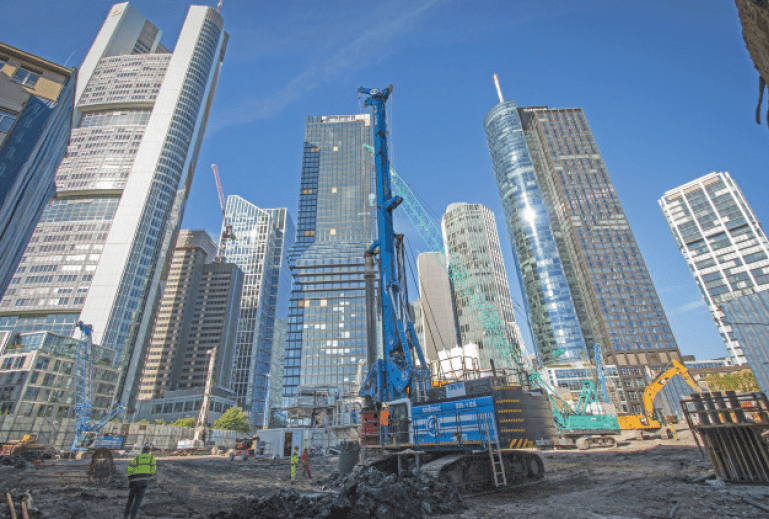
Trevi faced and won the challenge of carrying out all the foundation works in a rather complex context
Submitted by Trevi Group
Four Frankfurt is a unique high-rise building in the heart of Frankfurt’s city centre in Germany. Thanks to its purchase in 2015, Groß & Partner Grundstücksentwicklungsgesellschaft laid the foundations for the execution of this mega-project.
This building development includes four new high-rise buildings on a multi-level and multifunctional construction foundation. Thanks to the development’s 228-metre-high office tower, the building is the highest office space in Germany and, with its slightly shorter 173-metre-high tower, the development also touts the highest residential tower in Germany. Parts of the existing buildings will be kept to comply with historical preservation requirements and will be integrated into the new construction.
Due to the simultaneous execution of the work in all areas and the relevant logistical needs, which add to the enormous pressure set by the time limit, one of the main challenges of the construction process concerns its position in the city centre.
The four towers of the Four Frankfurt Project are supported by a base slab and its perimetral walls. Due to space restrictions, the client decided to build the basements using the top-down construction method. This means that, at first, the diaphragm wall and the foundation piles are constructed and then the concrete slab is poured to form the first basement floor.
Subsequently, excavation works take place under that cover and the other basements floors are built in the same way while construction of the building can start simultaneously.
Since the distance between the opposite walls of the perimeter would span over 100 metres, prefabricated columns were positioned into the piles to support the slabs. The structural loads of the above-ground structures and of the slabs are directly supported by the construction piles through the columns.
The foundation and excavation protection enclosure are carried out using the diaphragm wall method. In this case, two different methods are used.
Generally, the excavation of the panels is carried out using a clamshell. However, due to the strength of the limestone banks, a hydromill is also used to minimize the impact generated by vibrations on neighbouring structures.
Large diameter bored piles ranging from 1,500 to 2,000 millimetres are used as foundation elements. In the upper part, a temporary casing is used. Then, in the lower part, uncased drilling is carried out using stabilizing bentonite mud to reach a total drilling length of up to 50 metres.
After reaching the design depth, the reinforcement cage is installed, then the cement is poured into the shaft. Since the working level is significantly higher than the foundation level, the reinforcement cage is placed up to 20 metres below the working level.
Due to the selected top-down construction method, it is necessary to position the plunged columns in the piles. Since these prefabricated columns are not just temporary supports, but are also used as permanent columns in the basement floors, their installation requires meticulous precision.
Therefore, a maximum vertical tolerance of two centimetres and a maximum horizontal tolerance of five cm was allowed. For this reason, an innovative system is adopted for this project. After reaching the design depth of the pile, the reinforcement cage is installed, and subsequently a collar and a sleeve are positioned around and into the casing. The sleeve serves to guide the precast column and support its assembly.
In the next step, the position of the sleeve is suitably adjusted by using the adjusting screws on the collar in compliance with the given tolerance requirements. After the adjustment of the sleeve, the pile is backfilled with cement using a tremie pipe and then the prefabricated column is installed, guided by the sleeve, inserting it for three metres into the fresh cement of the pile.
-
Donald Bailey’s Bridge
April 23, 2024 -
From Historic Foundations to Modern Marvels
April 18, 2024 -
Canadian Construction Trends for 2024
April 16, 2024 -
Substance Use in the Trades
April 12, 2024 -
Putting Technology to Work in Your Business
April 12, 2024
